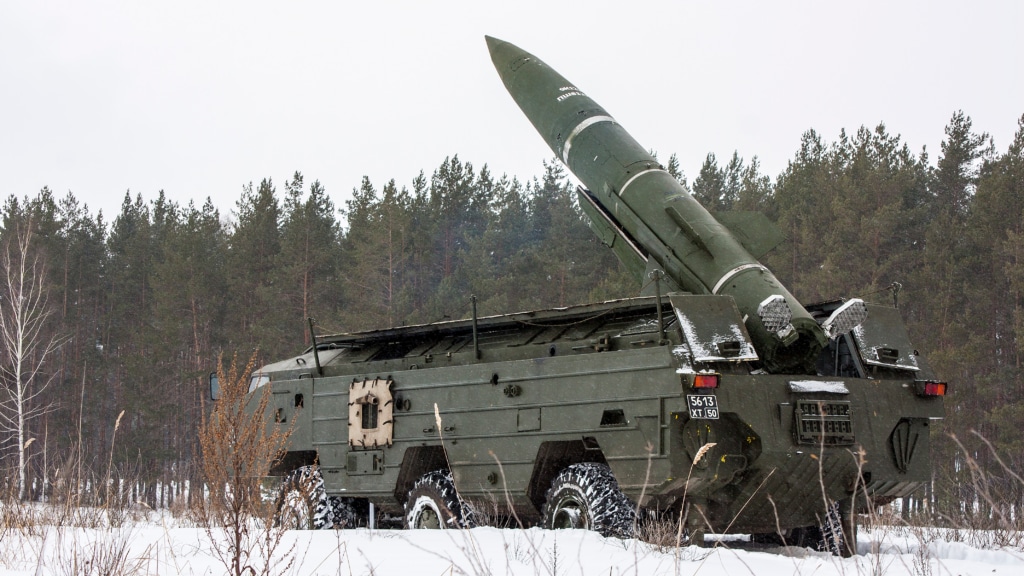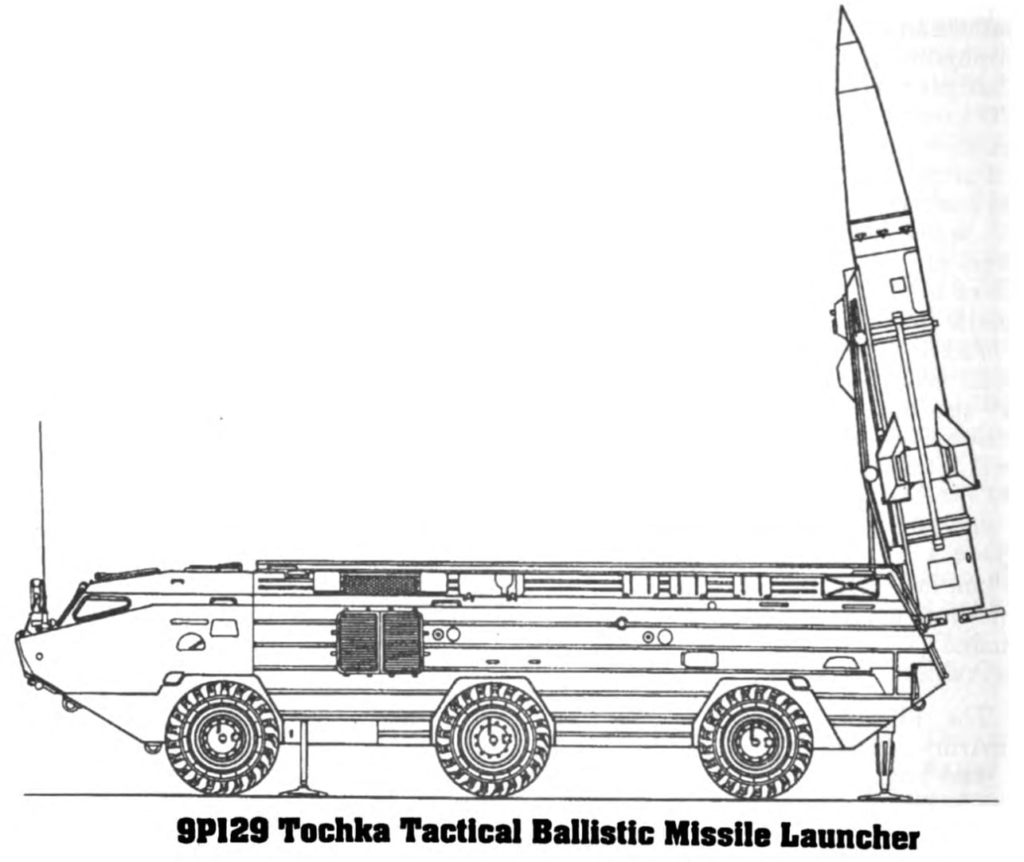The OTR-21 Tochka (NATO: SS-21 “Scarab”) is a short-range, road-mobile, solid propellant, single warhead ballistic missile designed for battlefield deployment. It was designed as a replacement for the Free Rocket Over Ground (FROG) missile series. Reports suggest that it can be launched in either a ballistic or cruise missile mode.1 The ballistic mode provides an increased range and speed, but the cruise mode allows for stealth and higher accuracy. Two versions are confirmed to have been developed, the ‘Scarab A’ and the ‘Scarab B’ (Tochka U).
OTR-21 Tochka (SS-21 “Scarab”) at a Glance
- Originated from
- Soviet Union
- Possessed by
- Russia, Armenia, Belarus, Kazakhstan, North Korea (KN-02), Syria, Ukraine, Yemen
- Alternate names
- Scarab, Tochka, OTR-21, 9M79
- Class
- Short-range Ballistic Missile (SRBM)
- Basing
- Road-mobile
- Length
- 6.4 m
- Diameter
- 0.655 m
- Launch weight
- 2,000 kg (A), 2,010 kg (B)
- Payload
- Single warhead, 482 kg
- Warhead
- HE, chemical, or nuclear (A), HE, chemical, nuclear, or submunitions (B)
- Propulsion
- Single-stage solid propellant
- Range
- 70 km (A), 120 km (B)
- Status
- Operational
- In service
- 1975



SS-21 Tochka Development
It is a tactical system designed to be deployed alongside conventional forces. The combination of its multiple warhead options, its cruise flight profile and the mobility of its Transporter-Erector-Launcher (TEL) vehicle make it a flexible battlefield system. The system is effective against military units and troop concentrations using fragmentation and submunition warheads, while it can just as effectively disable electrical equipment, airfields and military facilities using its other warhead options. The system is also designed to provide tactical nuclear support on the battlefield. The Tochka provides the Russian armed forces with a conventional and nuclear support system. 2
The Scarab A missile was in development from 1968 until 1974, and entered service in 1975. The Scarab B was developed between 1984 and 1988, and entered service in 1989. It is believed that Russia currently possesses 300 TEL vehicles and 310 nuclear warheads for all versions of the Tochka. This is down from a 1993 peak of 1,200 missiles. In 1996, a life extension program was started to add another ten years to the original 15-year service life of the Scarab B, with the first refit flight test occurring in October 1999.
Scarab A (OTR-21A)
The Scarab A has a range of 70 km with an accuracy of 150 m CEP. It launches a 482 kg warhead which can be equipped with submunitions, 120 kg of high explosive (HE) fragmentation filling or a nuclear device. The submunition types are anti-tank, anti-personnel, and anti-runway, while the nuclear device is believed to have a selectable yield of 10 or 100 kT. The missile is also believed to be capable of carrying an EMP warhead and can be calibrated to airburst at the desired altitude. It uses an inertial guidance system. The missile is 6.4 m long, 0.65 m in diameter, and has a launch weight of 2,000 kg. It uses a single-stage solid-propellant engine.3
Its TEL vehicle is amphibious with the ability to drive 60 km/h (37 mph) on-road and 8 km/h (5 mph) in water. It has the capacity of driving over rough terrain and carries a crew of three. It has Nuclear, Biological and Chemical (NBC) filter systems enabling it to operate in areas where Weapons of Mass Destruction (WMD) have been deployed. This is important, due to the threat of non-conventional warfare on the modern battlefield.4
Scarab B (Tochka U, OTR-21B)
The Scarab B has improved on its predecessor’s range to 120 km, and has included an anti-radar blast warhead. It uses inertial guidance giving it an accuracy of 95 m CEP. The missile has the same physical dimensions as the Scarab A, with a slightly heavier launch weight of 2,010 kg.5
Its TEL vehicle is also amphibious with the ability to drive on-road and in water. The TEL vehicle can be ready for launch in 16 minutes, can launch a missile in 2 minutes and it can be reloaded in 20 minutes. It too has Nuclear, Biological, and Chemical (NBC) filter systems.6
Unconfirmed reports claim the existence of a second upgrade, the Scarab C. This missile would have an increased range of 185 km (115 miles) and would fit two missiles to a TEL vehicle. This model was likely never made operational.7
It is believed that in 1999 the Russians used 60 to 100 SRBM in Chechnya, the majority of these being Tochka missiles. Ukraine is reported as possessing 500 missiles. Around 80 have possibly been exported to Yemen and another 40 (along with 12 TEL vehicles) to Syria. Recently Armenia has paraded several Tochkas in September of 2011.
An unconfirmed report alleges that Syria exported a small number of Tochka missiles and their TEL vehicles to North Korea in 1996 for the purposes of reverse engineering. In May 2005 North Korea tested a missile that may be a North Korean variant of the Tochka; since that time the missile has become a major part of North Korea’s ballistic missile forces, with a locally produced variant known as KN-02.
A variant of the missile has also been heavily used in the Yemen conflict, and several intercepts by Saudi and UAE Patriot missile defense batteries have been reported throughout 2015 and 2016 (see The Missile War in Yemen).
Russia has been phasing out its Tochka arsenal with the Iskander-M, which has greater range and can carry more than one missile per launcher.8
Footnotes
- “OTR-21 Tochka (SS-21 ‘Scarab’/9M79).” in IHS Jane’s Weapons: Strategic 2015-2016, ed. James C. O’Halloran (United Kingdom: IHS, 2015), 82-84.
- “OTR-21 Tochka (SS-21 ‘Scarab’/9M79).” in IHS Jane’s Weapons: Strategic 2015-2016, ed. James C. O’Halloran (United Kingdom: IHS, 2015), 82-84.
- “OTR-21 Tochka (SS-21 ‘Scarab’/9M79).” in IHS Jane’s Weapons: Strategic 2015-2016, ed. James C. O’Halloran (United Kingdom: IHS, 2015), 82-84.
- “OTR-21 Tochka (SS-21 ‘Scarab’/9M79).” in IHS Jane’s Weapons: Strategic 2015-2016, ed. James C. O’Halloran (United Kingdom: IHS, 2015), 82-84.
- “OTR-21 Tochka (SS-21 ‘Scarab’/9M79).” in IHS Jane’s Weapons: Strategic 2015-2016, ed. James C. O’Halloran (United Kingdom: IHS, 2015), 82-84.
- “OTR-21 Tochka (SS-21 ‘Scarab’/9M79).” in IHS Jane’s Weapons: Strategic 2015-2016, ed. James C. O’Halloran (United Kingdom: IHS, 2015), 82-84.
- “OTR-21 Tochka (SS-21 ‘Scarab’/9M79).” in IHS Jane’s Weapons: Strategic 2015-2016, ed. James C. O’Halloran (United Kingdom: IHS, 2015), 82-84.
- Hans M. Kristensen and Robert S. Norris, “Russian Nuclear Forces, 2016,” Bulletin of Atomic Scientists 72, no. 3, 132, http://www.tandfonline.com/doi/pdf/10.1080/00963402.2016.1170359